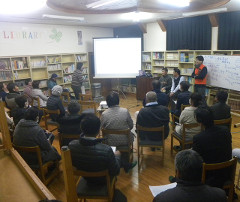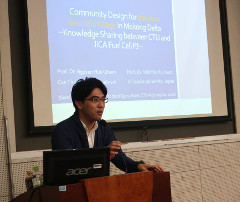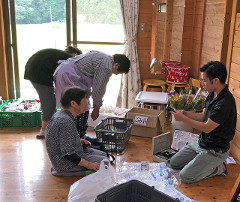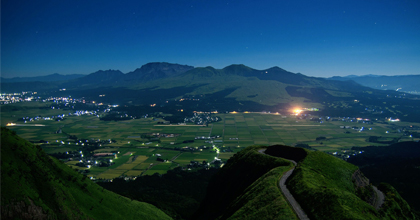Design for the future that can be seen by picturing the abundance of a community
 Workshop on recycling and composting household garbage with Hioki City, Kagoshima Prefecture
Workshop on recycling and composting household garbage with Hioki City, Kagoshima Prefecture
The depopulation of rural areas and the decline of regional industries in Japan have been major problems for a long time. It is the case that most farming, mountain or fishing communities are in a critical condition as attention was paid to marginal villages or municipalities at the risk of disappearing. Although I also engage in solving the problems, I’m not optimistic about them at all.
So do such farming communities really have no attraction, no leaders, and no future?
The primary industry, which is the main industry of farming communities, can be considered as activities to get blessing of working on nature in a community. The community here is not an administrative district such as a municipality, but a self-sufficient zone supported by the natural and ecological environments in the local area and can be defined as an area where people who share the same world view live.
Actually, farming communities in Japan have a long and rich history and culture of self-sufficiency in food, clothing and housing in harmony with the natural and ecological environments. That experience is the source of the attraction of farming activities.
As a way to revitalize a community, endeavors for the sixth industrialization can be made by combining agriculture and processing.
I have no intention of opposing such activities, but in a sense, this is a strategy to introduce the market economy ethics into farming activities and to win or lose. Of course, not everyone can win. I don’t think that just the strategy to compete with the outside can enhance the inherent value and attraction of rich and broad farming activities.
Farming communities could hardly be revitalized just by promoting agriculture alone in this way to gain financially.
Rather, I think it is important to comprehensively reconstruct an affluent life to receive the blessings of nature in a community of the size that allows local residents to equally receive the blessings. This should be considered as a regional economy to protect livelihoods.
For that reason, we must discover the inherent value and attraction of farming activities and start community development or creation valuing those aspects.
For example, there are technologies to utilize water, wind, the sun and the heat of the earth as renewable energy. It is possible to convert nature in a community into resources easy to use in various ways. We have developed small hydropower generation technology to enable local small and medium-sized companies and residents to jointly utilize the abundant water in hilly and mountainous areas of Japan.
Examining those local resources from various perspectives and combining them make it possible to imagine an ideal farming community in the future and design a new lifestyle counting backward from the future.
I call this community planning theory oriented toward the future “farming community development and natural resource planning.” I believe that the design of the future of a farming community will reveal the affluent lifestyle, livelihood and view of life and death unique to the community.
Construction of an economic cycle by connecting things in the community
 Seminar in Can Tho University, Vietnam Date: January 8, 2020
Seminar in Can Tho University, Vietnam Date: January 8, 2020
If natural environments or climates are different, local resources are also different.
For example, I am also engaged in solving problems in farming communities of the Mekong Delta in Vietnam. You may have an image of the Mekong Delta as a vast spread of paddy fields, but these were relatively newly cultivated after a waterway network was established by France, which colonized this area, in the 19th century.
However, in the 21st century, roads and bridges were developed to cross the waterways, and water transportation was replaced by land transportation. Then, the disused waterways were left unattended, so with overgrown waterweeds and stagnant household effluent, the hygienic environments of waterfront farming communities deteriorated.
Farming communities of the Mekong Delta are at sea level. The water cannot be used for small hydropower generation, as was done in hilly and mountainous areas of Japan. Therefore, we conducted a joint research with Can Tho University to produce biogas from household garbage and waterweeds to use as energy for cooking stoves, and to compost them to use in organic farming.
Just calling for improvements in the waterway environment cannot bring about residents’ action or change.
However, considering the cause of waterway environment deterioration as a resource in the community and thinking of a design to return the resource to residents’ lives in terms of economy as well can bring about a link between environmental improvement and economic activities as well as change in residents’ interests and consciousness. If this is continued, the community’s landscape will change. It is not just a dream to restore a rich waterfront community.
In Japan, I have engaged in community development in Gokase-cho, Miyazaki Prefecture, for 10 years. Agriculture focusing on tea-leaf cultivation and forestry are the main industries in this area, but a population outflow has continued, so the population has decreased to less than half of its peak in the 1950s.
But I’m not pessimistic at all. Residents in Gokase-cho are lively. They have set up a farmers’ market to sell vegetables and handmade goods as well as a welfare NPO to make places for elderly people. The Gokase Renewable Energy Institute was also established, which is a learning organization for residents to lead each community development activity on future-oriented initiatives.
Gaining courage from such activities of residents and carrying out various experimental activities together, we have realized their social impacts and will apply them to research. Each one of the residents’ creative practices is a light of hope to brighten the future of farming communities in Japan.
Discussions to decide the future of a community
 Route sales
Route sales
I believe the characteristic of farming life is politeness. There is a culture in which agricultural water channels and irrigation facilities are finely maintained and managed, and even roadside verges, which are not farmland, are mowed voluntarily. Residents create the beauty of farming communities in Japan.
I have realized something since the farmers’ market was set up in Gokase-cho. Everyone prefers handmade products. Everyone says that face-to-face relationships by living together in the same community are good and reliable.
The farmers’ market is always busy. I heard that even sales in April, May and June 2020 under the coronavirus crisis increased by about 1 million Japanese-yen from the previous year.
In this market, producers are not separate from consumers, and they buy others’ products. All residents share a world view as people who live in one community, accumulate farming activities, and serve as economic entities in the community.
This is a very small economy. But it suits this community, being just right and warmhearted.
I believe this is “well-being.”
It takes time for these efforts to lead to the community’s strength. It would be good to take about 30 years. A long-term cycle in which polite community development over 30 years is handed over to the next 30 years could work.
What strength can a community accumulate by taking time? It is the underlying strength that residents living in the community can draw their ideals, analyze the current situation, and discuss how to fill the gap between the future ideals and the current situation to make decisions one by one.
What we can do is create opportunities to reconsider the well-being in the community and places for actual discussion oriented toward the future.
We call this effort a “future dialogue.”
In Gokase-cho, which we are working on, we made the place at the site of an abandoned junior high school. In the campus made of local forest wood, the feelings of past residents who lived there have also been accumulated. This is a good place to accept the past and look toward the future. A nostalgic place can bring many people together. Moreover, junior high school students alone could go to junior high school, but anyone can come to the “school for community development” to do anything.
Because good community development means that everyone living in the community can live well or live richly, politely and livelily.
Discussions held at such a specific place can create an image of the community’s prosperous future and generate ideas to make use of the community’s inherent attraction on future-oriented initiatives. Those ideas are always generated by residents’ free and bold thinking. The future of a community can be realized by the imagination of people living in the community. Isn’t this exciting? I go to the communities with my heart fluttering, seeking the delight of being a part of moments when an idea pops up and an image of the future is widely shared.
I tend to be pessimistic when thinking in my office, while I can always brighten up when being at a “future dialogue.”
I feel things will work out. After all, farming communities have “something.”
* The information contained herein is current as of December 2020.
* The contents of articles on Meiji.net are based on the personal ideas and opinions of the author and do not indicate the official opinion of Meiji University.
* I work to achieve SDGs related to the educational and research themes that I am currently engaged in.
Information noted in the articles and videos, such as positions and affiliations, are current at the time of production.

